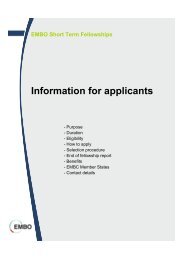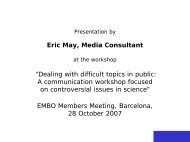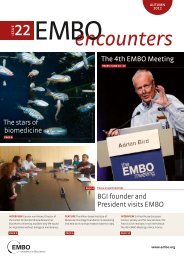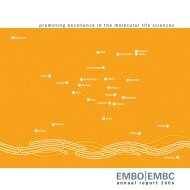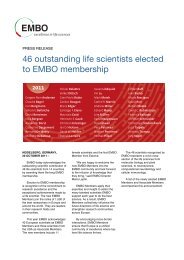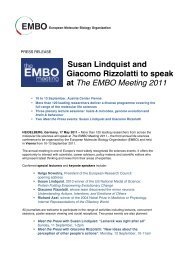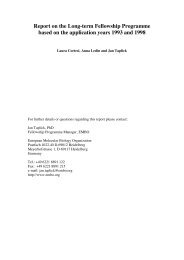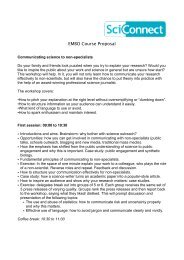EMBO Fellows Meeting 2012
EMBO Fellows Meeting 2012
EMBO Fellows Meeting 2012
You also want an ePaper? Increase the reach of your titles
YUMPU automatically turns print PDFs into web optimized ePapers that Google loves.
Mong Sing Lai<br />
<strong>EMBO</strong> <strong>Fellows</strong> <strong>Meeting</strong> <strong>2012</strong><br />
Mechanisms controlling terminal fork integrity and replicon dynamics following<br />
double strand break formation<br />
Abstract<br />
The understanding of the molecular mechanisms allowing cell survival in response to replication stress is<br />
important to elucidate those processes that protect the integrity of replicating chromosomes following<br />
oncogenic insults. In response to replication stress, Mec1/ATR-dependent checkpoint response and<br />
specialized SUMO/Ubiquitin pathways control the stalled and damaged replication fork stability. By contrast,<br />
Tel1/ATM-dependent checkpoint response and MRX/MRN complex protect the integrity of replication forks<br />
collapsing at the double strand break (DSB) sites (termed the terminal fork) preventing abnormal transitions.<br />
Recent data further suggest that Mec1/ATR-dependent checkpoint response controls the physical connections<br />
between replicating chromosomes and the nuclear envelope to facilitate fork progression across transcribed<br />
units and to prevent aberrant topological transitions at stalled replication forks. Using a combination of<br />
mechanistic and genomic approaches in budding yeast, we previously shown that terminal forks undergo<br />
through fork reversal (cruciform DNA intermediates) in tel1 cells, while in mre11 and sae2 cells, reversed forks<br />
are further processed by nucleolytic events. In this study, we aim at investigating the mechanisms leading to<br />
these pathological transitions at terminal forks. Fork reversal could be mediated by positive supercoiling<br />
downstream of the forks. However, this is unlikely in our context as DSB formation should resolve the<br />
topological constrains downstream of the fork. An alternative possibility is that fork reversal is mediated by<br />
precatenane derivatives that intertwine the two replicated duplexes behind the replication fork. We tested this<br />
possibility by overexpressing type II (TOP2) topoisomerase that should resolve precatenanes. Disrupting the<br />
tethering of transcribed genes to the nuclear pore complex was shown to counteract fork reversal in<br />
checkpoint-defective cells. We also tested whether nuclear envelope protein play any role in promoting<br />
reversed forks formation. We will discuss the possibilities that may contribute to the mechanisms controlling<br />
terminal fork integrity.<br />
Mong Sing Lai 1 , Ylli Doksani 1 , Marco Foiani 1,2<br />
1 FIRC Institute of Molecular Oncology Foundation (IFOM-IEO Campus), Via Adamello 16, 20139 Milan, Italy<br />
2 DSBB-Universita degli Studi di Milano, Milan, Italy<br />
14-17 June <strong>2012</strong>, Heidelberg, Germany




